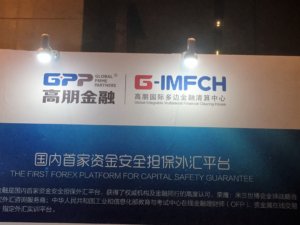Prime, prime of prime, and the Great Firewall. Just who is really providing genuine liquidity? – Live from Guangzhou
Here is how to check whether a Chinese liquidity provider is actually sourcing proper liquidity from genuine sources, and how to check if the terminology is being misused.

If there has ever been a time at which it could even be remotely appropriate to misuse the word ‘prime’, or create intentional ambiguity with regard to how institutional liquidity is provided to retail FX brokerages, then this year most certainly is not it.
During recent months, there has been tremendous discourse among industry participants globally with regard to how the order flow of their clients’ trades is being handled by their institutional liquidity provider, and whether genuine aggregated liquidity is being delivered via correct and proper prime brokerage relationships with Tier 1 banks.
This has made itself evident in some very high profile commercial demises, some intentional and some the result of the provider having not actually been processing trades to a live market, but instead operating a profit sharing model, which is akin to the HYIPs that existed en masse at the turn of this century.
Recent examples include the recent bankruptcy of Galant Capital Markets, which has had an enormous knock-on effect, creating deficits for many retail firms and also for other institutional providers that held capital with Galant – that in itself being a red flag, in that liquidity providers do not hold capital with other liquidity providers if they are genuine prime of prime brokers, and, according to substantial research by FinanceFeeds, has brought to the surface several deficiencies in a few firms globally that have purported to offer genuine liquidity via Tier 1 feed aggregation.
There is no doubt that the execution model at institutional level is under the spotlight – not from regulators, as they do not understand its component structure correctly in most jurisdictions.

Try going to CySec or any other European regional regulator and explaining to a beige-suited civil servant how to place capital with eFX desks at Tier 1 banks in Canary Wharf, and then electronically aggregating a price feed, before routing it via a liquidity management and order matching system from their single-dealer interbank platforms collectively, via an MT4 bridge to a retail trading platform.
Said civil servant will have headed for the Werthers Originals and poured his Ovaltine into his CSMA mug long before a chance to explain this in anything more than very brief form would present itself.
Here in Guangzhou, China, a different set of circumstances has arisen, complicating the process somewhat further.
During the past few years, FinanceFeeds CEO Andrew Saks-McLeod has spent a substantial amount of time and resources by committing to detailed research within mainland China, the absolute pinnacle of the retail FX industry in terms of its scale and opportunity.
The amount of volume and how it is traded here in China is not even comparable to any other region. Many IBs are larger than the brokers to which they send their trade flow, and the vast liquid monthly profit from vast realestate or agricultural projects that are viewed as long term investments are traded in FX. Nobody is interested in the limited and archaic stocks on China’s heavily restricted stock exchanges. They want real action and real profit, from vast investment sums.
Long consigned to the history books are the dark days of every conversation with every IB in China begins, continues and ends, interspersed with lengthy tea-consuming rituals, with “How much revenue share, and what are your costs?”
Today, the conversation focuses on the execution model, with priority being that real prime of prime brokerages are handling the order flow of any broker that wishes to provide services to any IB in China.
Nobody wants internalization and revenue share, such is the fear of retribution from the government or clients should an IB lose his client money to an overseas firm – highly frowned upon by the Chinese government, whose social stability policies do not take kindly to firms sending the investments of their clients to unvetted overseas firms that then make off with their capital.
The massive media campaign that ushered IronFX out of China is a first class example.
Since then, caution prevails, and high levels of understanding and knowledge among Chinese participants exists, even if they do not show it.
That has been answered largely by the influx into the mainland of Chinese subsidiaries of very highly respected Western firms, such as Swissquote, Advanced Markets & Fortex, Saxo Bank and AxiTrader, along with liquidity bridge firms (Gold-i has an office in Shanghai via a Wholly Owned Foreign Entity).
The difficulty nowadays is the aspirational nomenclature used among some of the firms that are applying their own services from the domestic Chinese market to domestic brokerages.

Liberal use of the words ‘prime brokerage’ or ‘mulitilateral clearing house and exchange’ are rife among some of the domestic firms that have presence across the nation from Shanghai to Shenzhen.
It has been absolutely notable that retail brokerages such as the perhaps unergonomically named G-IMFCH. No, that is not a personal insult, or the sound which accompanying a sneeze, it is an abbreviation of
Global Integrable Multilateral Financial Clearing House. It is questionable as to whether the word Integrable is in the Oxford English Dictionary, however the most important difficulty here is that this is neither a clearing house or a multilateral facility.
In other regions, for example Europe, MiFID categorizes financial markets operators across all of the derivatives sector into three specific sectors – the first being a systematic internalizer (SI), whcih is a counterparty that internalizes (b-books) all trades and is not a trading venue, the second being MTFs and OTFs, which are venues, and the third being a regulated marketplace (RM), which is a trading venue.
The main distinction between RMs and MTFs on the one hand and OTFs on the other is that the execution of orders on an OTF is carried out on a discretionary basis.
The nomenclature of G-IMFCH is at odds with this, yet in China, it is possible to continue with such a name, largely due to language barriers. In Chinese, the firm’s website and its corporate information clearly states that it is an MT4 retail brokerage, and when asked by FinanceFeeds here today in Guangzhou what the firm does, it was explained by staff that the company is an MT4 retail brokerage.
This is a matter to be careful of when looking at which specific services firms offer.
One particular company that has got this right is Bondex Global, which simply positions itself as ‘prime broker’ and is offering actual liquidity provision to retail brokerages in China, as opposed to being a retail broker posing as a liquidity provider.

A brief conversation this morning with senior members of staff at Bondex in Guangzhou allowed a very interesting insight that is worthy of note.
FinanceFeeds has maintained continuously that it is not possible to operate solely as a domestic market prime of prime and offer actual prime of prime liquidity, largely because China’s Tier 1 banks will only provide Yuan liquidity to local liquidity takers.
In order to gain correctly priced global aggregated liquidity and maintain a homogeneous Chinese system from the top down, Chinese brokerages must forge their relationships with the Chinese subsidiaries of Western prime of primes, as per those mentioned earlier in this article.
Thus, when seeking liquidity from Chinese partners, a few pointers are necessary, an example being the modus operandi and structure of Bondex Global.
Bondex Global, rather than providing liquidity to firms from within China and internalizing it, has a license with the Financial Conduct Authority in Britain, and a registered address in Britain, that being 1 Fore Street, London EC2. Although the London address is rather strangely the same premises as the WeWork co-working space, it is a London address that auditors could visit and that a responsible officer must be present for questions to be asked.
Bondex Global’s executives explained to FinanceFeeds in Guangzhou this morning that the firm takes liquidity from a selection of well recognized FX prime of prime brokerages in London (the names of which FinanceFeeds is privy to but has agreed to keep anonymous) along with non-bank electronic communication networks as well as directly from a London based bank as a main interbank liquidity provider.
There is indeed a case for ensuring that, when operating a Chinese brokerage and seeking liquidity, that the firm providing it has its registration and prime brokerage relationships in major financial centers such as London, Sydney or New York, where the interbank Tier 1 providers are located, a licesnse in the UK or Australia, and is aggregating its liquidity from outside of China, yet has the required Chinese entity in place within the mainland to ensure that the flow of liquidity is not interrupted and that service can be carried out with the right level of government supervision.
小心!- That’s ‘be careful!’ in Chinese.









